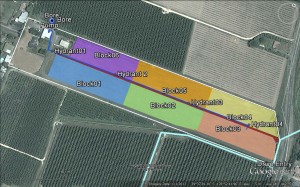In April 2013, we established a buried drip irrigation system at CLAW in Block 2.
The installation was done by ThinkWater Hawke’s Bay using dripline was sponsored by Netafim and other materials by ThinkWater. Thanks in particular to Anthony Waites for all his efforts and care in getting the job one well.
Ground preparation began withHayden Greville spraying out the existing pasture. Nicolle Contracting cross-ripped the area to 400mm then hoed the surface. This left a good surface and soiol conditions for the dripline laying rig.
The dripline is a 0.9mm wall thickness hose with 1 lph drippers at 400mm spacing was installed 762mm apart and 200+mm deep. This combination applies 3.2mm per hour using 4.16 lps on the half hectare block. That sits under our consent take rate limit of 4.8 lps, and applies a summer day’s water use in about an hour and a half.
While initial thoughts were for 400mm dripline spacing, we decided to try 762mm, or 30″ spacing to match the majority of process and other crops produced in Hawke’s Bay. The wide spacing will enable planting above a row of dripline which should be sufficient for row crops. It may prove to be a little too far apart for cereals or pasture – time will tell. The block was set up as two halves, with control valves and sub-mains to fit. If we halve the dripline spacing (double the number of drip lines) we can split the application and still fit within the consent and our pumping limits.
Dripline installation was by ThinkWater and Nicolle Contracting using Trimble RTK-GPS auto-steer. We know exactly where it is! This should allow us to do deep cultivation such as inter-row ripping without damaging the dripline. The initial installation has not used a flushing sub-main. We wanted the system in and running for the LandWISE field event and made do with individual dripline flushing. We will install the flushing sub-main; it is the only practical solution for a fully buried system like this.
System control is very simple. A battery powered clock sequencer controls two battery powered latching solenoid valves at field hydrant 2. The whole system in permanently pressurised so if the solenoid valves open, the pump will start up automatically. This suits us; it avoids electrically connecting the field valve station back to the pumpshed, and we only have one or two blocks to control. It is easy enough to set up and adjust as required.


